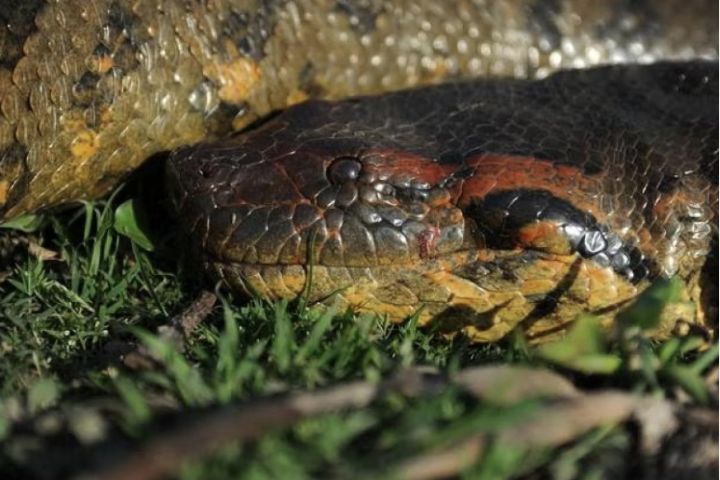The once-mighty green anaconda, long considered a singular Amazonian powerhouse, now stands revealed as two genetically distinct species. This groundbreaking discovery by our team upends existing scientific understanding and opens a fresh chapter in protecting these magnificent predators.
Heavyweight champions with surprising secrets
Green anacondas, the world’s heaviest snakes and some of the longest, reign supreme in South American rivers and wetlands. Renowned for their lightning strikes and ability to swallow prey whole, they’ve captivated us for centuries. Yet, even these giants held hidden secrets.
Two unique lineages emerge
To our astonishment, genetic analysis revealed significant differences between two distinct anaconda populations. Considering their size and visibility, it’s remarkable this diversity remained hidden until now. This revelation demands a complete overhaul of conservation strategies for each species, ensuring their survival amidst climate change, habitat loss, and pollution.
Beyond the headlines: Urgency and opportunity
Our findings underscore the urgent need to deepen our understanding of Earth’s biodiversity before it’s too late. The green anaconda case highlights how much remains undiscovered, even amongst iconic species.
Delving deeper: Anatomy of an apex predator
Historically, four anaconda species were recognized, with the green anaconda holding the spotlight. These reptilian behemoths, particularly females, can reach over seven meters and weigh over 250 kilograms. Perfectly adapted to aquatic life, their eyes and nostrils sit atop their heads, allowing them to breathe and observe while submerged. Their olive bodies adorned with black spots provide camouflage amidst the greenery.
Masters of ambush and adaptation
These giants inhabit the intricate waterways of the Amazon and Orinoco basins, renowned for their stealth, patience, and surprising agility. Water’s buoyancy aids their hefty bodies, enabling them to silently ambush prey as diverse as capybaras, caimans, and even deer.
Silent constrictors, vital ecosystem players
Unlike their venomous kin, green anacondas rely on their immense size and powerful coils to crush and swallow prey. As apex predators, they play a crucial role in maintaining ecosystem balance, influencing the behavior of countless other species and shaping their entire ecosystems.
Guardians of health: Anacondas as environmental barometers
Healthy anaconda populations signify thriving ecosystems with abundant food and clean water. Conversely, declining numbers can serve as alarming harbingers of environmental distress. Accurately identifying and monitoring distinct anaconda species is crucial for conservation efforts and understanding the health of their habitats.
Unlocking the future: Research paves the way
Until now, research into genetic variations within anaconda species remained limited. Our work aims to bridge this gap, providing invaluable insights for future conservation efforts.
Untangling the Anaconda’s Genetic Code: A 20-Year Journey
Our quest to unravel the mysteries of the green anaconda took us on a nearly 20-year journey, spanning nine countries and countless muddy rivers and sweltering swamps. This ambitious project involved collecting representative samples from all known anaconda species across their entire distribution.
A Collaboration in the Amazonian Wilds
A pivotal moment came in 2022, when an invitation from Waorani leader Penti Baihua led us to the Bameno region of Baihuaeri Waorani Territory in the Ecuadorian Amazon. This expedition, in collaboration with the Waorani community and accompanied by actor Will Smith for his National Geographic series, proved instrumental in collecting crucial data.
Beyond Appearances: Unveiling Hidden Diversity
Despite their seemingly identical appearance and lack of obvious geographical barriers, our analysis revealed a startling truth: the “green anaconda” actually comprises two distinct species with a staggering 5.5% genetic divergence (compared to just 2% between humans and apes). We named them “southern green anaconda” (Eunectes murinus) and “northern green anaconda” (Eunectes akayima), based on their respective geographic distributions.
A Million Years in the Making
Our research suggests these species diverged almost 10 million years ago, highlighting the hidden complexity of the Amazonian ecosystem. This discovery underscores the critical need for species-specific conservation strategies.
Tailoring Conservation for Two Green Giants
Treating these anacondas as a single unit can leave the newly identified northern species vulnerable. Each species likely occupies unique ecological niches and faces distinct threats. Tailored conservation efforts are crucial, potentially involving focused legal protections, habitat preservation initiatives, and measures to mitigate climate change, deforestation, and pollution (such as the devastating effects of oil spills).
Beyond the Green Anaconda: A Call for Broader Recognition
This discovery serves as a powerful reminder of the vast unknowns within our world’s biodiversity. Unrecognized species can easily slip through the cracks of conservation efforts. Integrating genetic taxonomy into conservation planning is key to preserving Earth’s intricate web of life, safeguarding both the known and the waiting-to-be-discovered.
source news:
Bryan G. Fry, Professor of Toxicology, School of the Environment, The University of Queensland





